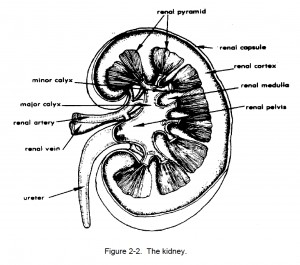a. The kidneys (figure 2-2) are a pair of bean-shaped organs about four inches long, two inches wide, one-inch thick, and weighing four to six ounces each.
b. One kidney is located on each side of the body. They are pressed against the posterior abdominal wall at about the level of the first lumbar vertebrae.
c. The medial side of each kidney is concave and has a central notch called the hilum. Here, the renal artery enters the kidney, and the renal vein and ureter exit the kidney. Nerves and lymphatic vessels also pass through the hilum.

d. The kidneys are enclosed by the renal capsule. Directly beneath the capsule lies a reddish area called the renal cortex. The cortex contains millions of microscopic filtration plants called nephrons. Nephrons are the functional units of the kidney.
e. Beneath the cortex is a reddish-brown area called the renal medulla. Within the medulla are striated areas called the renal pyramids. Urine collecting tubules within the pyramids cause the striated appearance.
f. The collecting tubules terminate at the pyramid’s point, emptying the urine into the renal pelvis. Along the edges of the renal pelvis are cup-like projections called the minor and major calyces. Each minor calyx collects urine from the pyramid and empties it into a major calyx. The major calyces empty into the renal pelvis.
